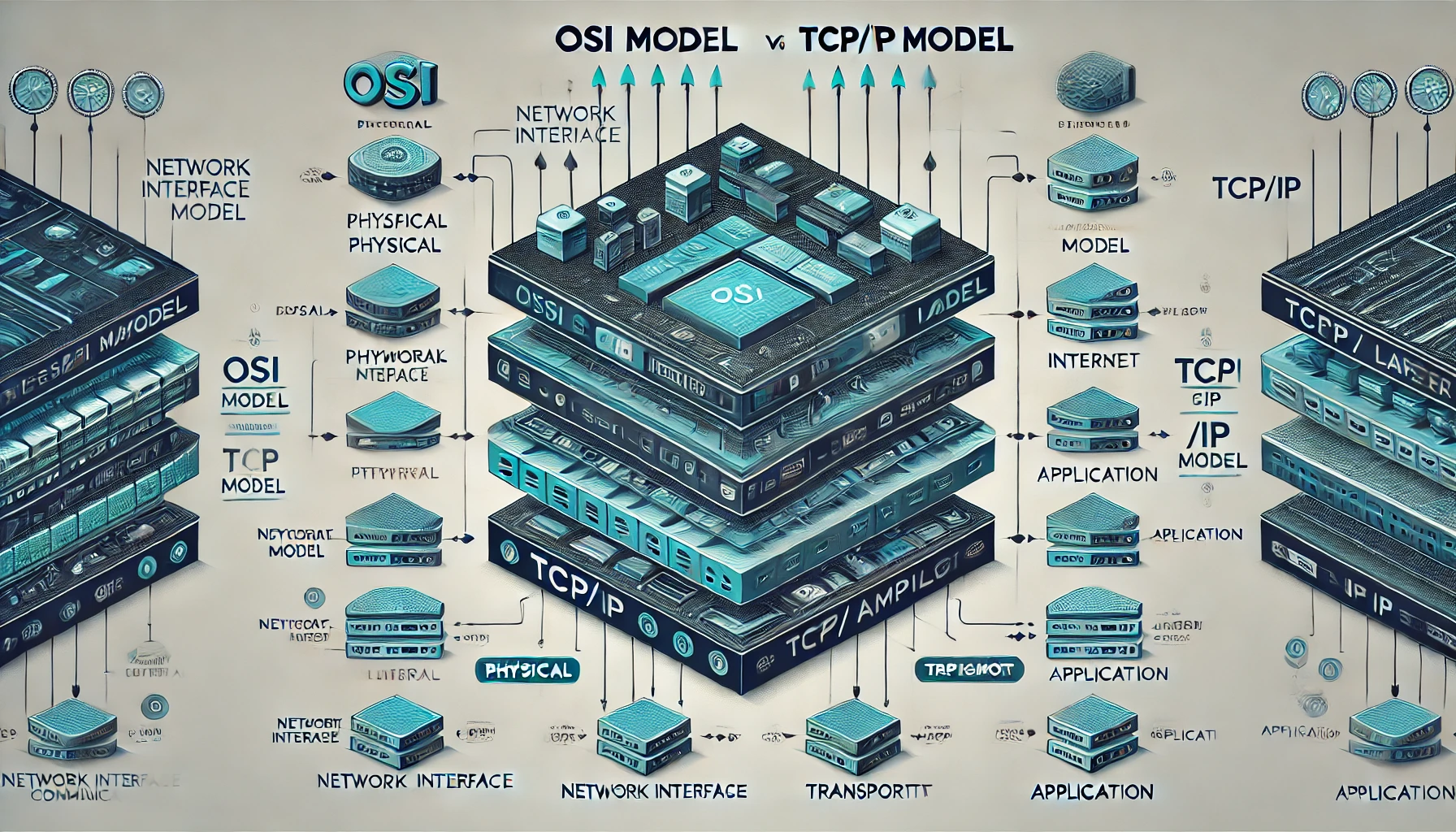In the world of networking, two models are fundamental to understanding how data is transmitted over networks: the OSI Model and the TCP/IP Model. Each model breaks down network communication into layers, making it easier to troubleshoot and comprehend complex data transfer processes. Let’s explore “OSI model vs TCP/IP model” – the key differences, functions, and significance of each model in this detailed comparison.
🌐 What is the OSI Model?
The OSI (Open Systems Interconnection) Model is a conceptual framework used to describe the functions of a networking system. It organizes communication into seven layers, each with distinct roles that contribute to the transmission of data across a network. The OSI model provides a standardized approach, making it easier for different systems to communicate.
🖥️ What is the TCP/IP Model?
The TCP/IP (Transmission Control Protocol/Internet Protocol) Model is a more practical framework, used predominantly in the real-world for internet communications. It simplifies the seven layers of the OSI model into four layers that mirror actual internet architecture. It is the core model behind all TCP/IP networks, including the internet.
🚦 Layer-by-Layer Comparison: OSI Model vs TCP/IP Model
| OSI Model Layers | Function | TCP/IP Model Layers | PDU | Hardware | Protocols |
| 1. Physical | Defines the physical aspects of network communication, including cables, connectors, voltage levels, and transmission speed. | Network Access/Link Layer | Bits | NICs, Cables, Hubs | Ethernet, Wi-Fi, Token Ring, Bluetooth, ISDN |
| 2. Data Link | Facilitates node-to-node data transfer and handles error detection/correction. Adds MAC addresses for node identification. | Network Access | Frame | Switches, Access Points | ARP, PPP, SLIP, Wi-Fi (IEEE 802.11), Frame Relay |
| 3. Network | Handles logical addressing and routing of data using IP addresses. Ensures that packets are correctly delivered to their destination. | Internet | Packet | Routers, Layer 3 Switches | IP, ICMP, IGMP, IPsec, NAT |
| 4. Transport | Ensures error-free data transfer by segmenting data and ensuring delivery through protocols like TCP and UDP. | Transport | Segment | Gateways, Load Balancers | TCP, UDP, SCTP, DCCP |
| 5. Session | Manages sessions between applications, establishing, maintaining, and terminating connections. | (Part of Application Layer) | – | PCs, Mobile Devices | SMB, RPC, NFS |
| 6. Presentation | Translates data into a format that the application layer can understand, encrypts/decrypts data if needed. | (Part of Application Layer) | – | – | SSL, TLS, JPEG, GIF, HTTPS |
| 7. Application | Closest to the end-user, this layer facilitates interaction between applications and lower layers. | Application | Data | Proxy Servers, Firewalls | HTTP, FTP, DNS, SSH, SMTP, SNMP |
📊 Key Differences Between the OSI and TCP/IP Models
Layer Structure: The OSI model consists of 7 layers, while the TCP/IP model has only 4 layers. The TCP/IP model combines the functions of the OSI model’s session, presentation, and application layers into a single application layer.
Adoption: The TCP/IP model is the practical framework used in modern internet communications, whereas the OSI model is more of a conceptual tool, ideal for understanding how networking works in theory.
Transport Layer Protocols: The OSI transport layer uses TP0 to TP4 protocols, whereas the TCP/IP transport layer primarily uses TCP and UDP to ensure data delivery.
Real-World Use: The TCP/IP model is simpler and aligns more closely with how the internet operates, making it more widely adopted for practical networking tasks.
🛠️ Practical Application of OSI and TCP/IP Models
When it comes to troubleshooting network issues, both models are invaluable. Here’s how:
OSI Model for Diagnosis: Network engineers often use the OSI model to pinpoint where an issue might be occurring. For example, if there is a problem with routing, engineers will check the Network Layer (Layer 3) to see if packets are being routed correctly.
TCP/IP for Real-World Networking: The TCP/IP model is widely used in the design and deployment of networks, as it closely mirrors actual protocol use on the internet. This makes it ideal for practical applications, such as configuring routers, switches, and firewalls.
🔄 Layer Functions Simplified
Physical Layer (OSI): Transmits raw bits over a physical medium (e.g., cables, fiber optics).
Network Layer (TCP/IP): Routes packets through different networks using IP addresses.
For a detailed understanding of how each model operates, check out more networking blogs on our site, including “Mastering TCP/IP Protocols for Efficient Networking” and “The Importance of OSI Layers in Modern Networks”.
Conclusion: OSI model vs TCP/IP model
Understanding the OSI model vs TCP/IP model comparison is critical for anyone involved in networking. While the OSI model is a comprehensive framework used for educational purposes, the TCP/IP model drives real-world internet communication. Both models serve their purpose, helping IT professionals design, troubleshoot, and optimize networks.
By learning both models, you gain a deeper understanding of how data travels through a network—from the physical cables (Layer 1) to the applications (Layer 7 or Application Layer in TCP/IP). Whether you’re managing a home network or an enterprise system, these models provide essential insights for building robust, efficient network architectures.

















